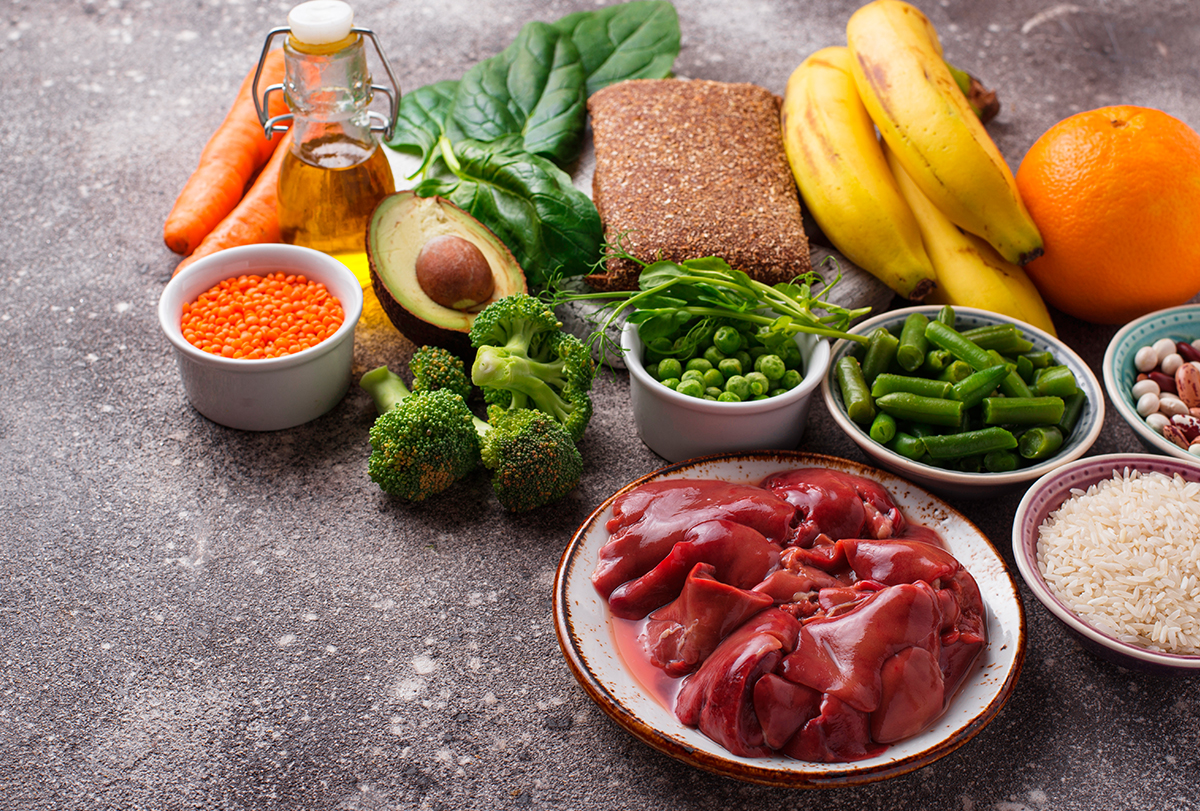
You might not think twice about what you eat daily. But inside, things shift quietly. Your blood cells depend on more than iron. Other nutrients help your body build hemoglobin. A single meal can support or slow that process. Patterns matter more than isolated choices.
A steady lack of certain foods leads to silent drops
When iron stays low over time, your body slows red cell production. The decline can happen gradually. Fatigue creeps in. You might blame work or stress. But under it all, your body’s engine is slowing. Low hemoglobin doesn’t always scream. Sometimes it just whispers.
Your gut can’t absorb what it can’t process
It’s not just what you eat, but what your body can use. Absorption depends on other players. Vitamin C helps, while calcium might compete. Some grains bind iron and carry it out. A plate filled with good food doesn’t always mean your cells are getting it.
You may eat enough iron, but it never reaches your bloodstream
Non-heme iron, found in plants, is harder to absorb. It’s affected by coffee, dairy, and fiber. Without vitamin C nearby, much of it passes unused. A bowl of spinach can’t work alone. Timing and food pairings change how much your body holds on to.
Iron supplements may not help if your meals work against them
Taking iron tablets while drinking milk dulls their effect. The same goes for antacids. They reduce stomach acid, which is needed for absorption. Supplements aren’t magic. They need a supportive environment. What you eat around them matters more than you think.
You might lose iron faster than you’re replacing it
Menstruation, donation, and even endurance exercise increase demand. Heavy periods drain reserves. Runners often break red cells from impact. If your diet doesn’t keep up, hemoglobin falls. And if you don’t notice the signs, the drop deepens over weeks or months.
B12 and folate walk beside iron in the same path
Your body needs more than iron to build healthy blood. B12 and folate support DNA synthesis. Without them, red cells form poorly. They may still carry hemoglobin, but less efficiently. Even with enough iron, your blood might still struggle if these partners fall behind.
Skipping meals creates silent gaps in essential nutrients
Intermittent fasting might work for some goals. But without planning, it limits intake. Hemoglobin needs daily input. Missed breakfasts, light lunches—these add up. Your blood doesn’t have memory. It can’t save iron from last week. It needs consistency, not intensity.
Plant-based diets need closer attention to hemoglobin markers
Meat offers easily absorbed iron. Without it, careful planning becomes vital. Beans, lentils, and seeds carry iron too. But absorption is less efficient. Pairing with vitamin C is crucial. Avoiding tea or coffee around meals helps. Otherwise, hemoglobin may slowly dip.
Tea and coffee interrupt more than your focus
Tannins found in black tea and coffee bind iron. They block its path before absorption begins. Drinking them with or right after meals lowers hemoglobin gains. Shifting your drink habits can make a visible difference. A small delay changes what your blood receives.
Anemias caused by poor diet don’t always present the same
You might feel tired. But you might also feel cold, dizzy, or restless. Cracks at the corners of your mouth. Pale skin. Brittle nails. These signs differ. They don’t always link back to food in your mind. But your blood reflects your plate’s memory.
Overcooked greens might look healthy but lose key nutrients
Boiling spinach too long drains vitamin C. Overcooking destroys folate. What’s left might still be fiber, but little support for hemoglobin. Steaming or sautéing preserves more. Cooking methods shape nutrient value, even when ingredients remain the same.
Combining citrus with iron-rich foods can change outcomes
A squeeze of lemon can do more than add flavor. It increases non-heme iron absorption. Vitamin C transforms the bioavailability of plant sources. Citrus, bell peppers, tomatoes—these work quietly but powerfully. One simple pairing shifts how your body builds blood.
Diets low in protein also risk dropping hemoglobin
Hemoglobin is a protein. Without building blocks, your body can’t form it efficiently. Beans, meat, dairy, eggs—all offer amino acids. Skipping protein impacts more than muscle. It touches your blood directly. Prioritizing protein sustains more than strength.
Chronic dieting may create lasting blood deficiencies
Yo-yo diets reduce intake of key minerals. Rapid weight loss pulls nutrients out faster than replenishment. Some restriction-based trends ignore iron, B12, or folate. These holes don’t always refill quickly. What seems temporary can leave lasting impacts on hemoglobin levels.
Alcohol reduces your body’s ability to form healthy red cells
Heavy drinking interferes with folate metabolism. It also impacts liver function, which affects blood production. Even moderate use can lower nutrient absorption. If your hemoglobin remains low without clear reason, alcohol intake may play a hidden role.
Digestive disorders reduce nutrient availability even with good meals
Celiac disease, Crohn’s, and IBS alter absorption. Even the best diets might not be enough. Damage to the gut lining limits nutrient intake. Iron, B12, and folate pass through unclaimed. Diagnosing and managing the root issue supports blood health long-term.
Pregnancy raises iron needs beyond typical levels
Growing another body increases blood volume. Hemoglobin must rise to meet demand. Without enough intake, both mother and baby may face issues. Iron-rich meals and prenatal supplements become essential. Ignoring this can cause complications even months after birth.
Low hemoglobin can worsen if paired with vitamin A deficiency
Vitamin A supports the release of iron from storage. Without it, your body holds iron in reserve. Blood levels drop even when total iron remains. This mismatch often goes unnoticed. Including orange fruits, liver, or leafy greens helps balance the process.
Excess calcium can block iron if consumed at the wrong time
Large amounts of dairy or calcium supplements interfere with iron absorption. Timing matters. Taking them separately avoids this clash. Even healthy foods can compete. Understanding these internal negotiations improves blood health without new prescriptions.
Cooking in cast iron pans can add small amounts of iron
Especially with acidic foods like tomato sauce, iron leaches from the pan. It’s a quiet supplement. Not enough to replace food, but enough to count. Over time, this subtle boost supports red cell production. Old tools still carry quiet wisdom.
Cravings for ice or dirt may signal low hemoglobin
Pica is often linked to iron deficiency. Chewing ice, craving clay, or starch. These urges aren’t random. They’re clues. When hemoglobin dips, your body signals creatively. Listening to those strange cravings can lead to early detection and care.
Sudden hair loss can sometimes relate to anemia
Hair growth slows when blood lacks oxygen. The body prioritizes vital systems first. Skin, nails, and hair take a hit. If hair sheds more than normal, check hemoglobin. It might not be stress. It might be cells gasping quietly.
Emotional symptoms may show before physical ones
Irritability, poor concentration, or anxiety might come first. Blood health affects brain function. Low hemoglobin reduces oxygen to neurons. Thinking feels harder. Mood shifts. These aren’t always linked to food but often are. A blood test brings clarity.
Some medications reduce hemoglobin-supporting nutrients
Metformin lowers B12. Antacids reduce iron absorption. Birth control pills alter folate metabolism. These effects are subtle but cumulative. Reviewing medication side effects with a doctor helps uncover diet-related blood changes. It’s not always about what you eat—but also what blocks absorption.
Sleep plays a role in regulating iron metabolism
Rest influences hormones tied to nutrient balance. Chronic insomnia or short sleep alters blood-building processes. Melatonin also interacts with iron regulation. Over time, poor sleep affects more than mood. It shifts how your body uses nutrients.
Combining small changes builds a strong blood foundation
No single food will fix hemoglobin. No single day will either. But patterns build blood. Meal after meal, pairing after pairing. A little lemon. A missed tea. A handful of lentils. These build quietly until blood becomes stronger again.
